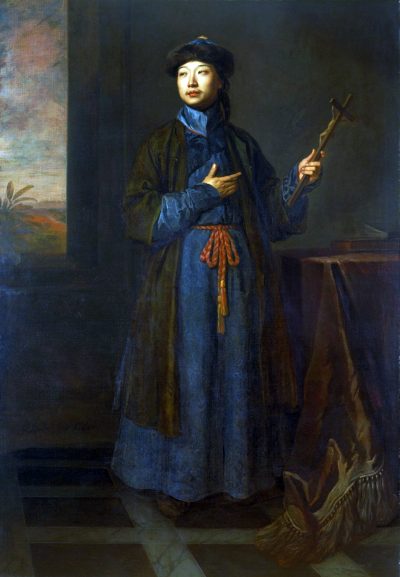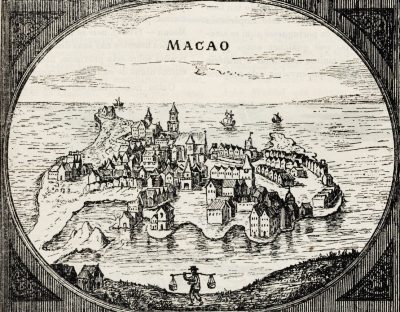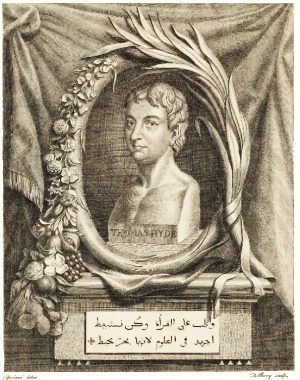History of early British contacts with China to 1700
The history of direct Chinese contacts with Britain is surprisingly short. Most chroniclers begin their survey with the spectacular Macartney mission to China in 1793 but this was not the first. An intriguing very early contact should first be mentioned. Archaeologists in 2016 analyzed the teeth of skeletons from Roman London ➚. The remains of two people dating from 2nd to 4th centuries CE seem to be of Chinese/Asian origin. Were Chinese traders active in London two thousand years ago, or were they slaves? Unfortunately it’s unlikely that anything more can be deduced from this remarkable discovery.

Although Marco Polo’s tantalizing story of a vast and immensely rich country had been widely read since it had been published in about 1300, other first-hand reports of China were scarce. It was only in the 16th century with the opening up of sea routes via the Cape of Good Hope that Spanish and Portuguese merchants became active in the China trade. This then triggered a surge of British interest in the Asia trade. In the early 1500s Portugal had been busy setting up its port at Macau and at the same time Spain in the Philippines. The first attempted British contact was in around 1553 when King Edward VI sought to open up the wool trade to a new market. This scarcely known embassy set off overland but only got as far as the Caspian Sea.
Queen Elizabeth I
Interest in China was further kindled in 1577 with the publication of the first book in English concerning China: ‘Certyne Reportes of the Province China, learned through the Portugalles...’ translated by Richard Willes. Another book ‘A Discourse of the Navigation which the Portugales doe make...’ soon followed in 1579.
These reports led to the first well documented mission was the embassy sent out by Queen Elizabeth I in 1579. Britain was keen to become involved in the lucrative trade in spices, silk and porcelain in exchange for wool - its most precious export at this time. The embassy included John Newbery, Thomas Bromefield, Richard Allot and Ralph Fitch. They carried a letter to the Emperor in the hope of opening up trading relations. In the letter Queen Elizabeth wrote: “For by this means we perceive, that the profit which by the mutual trade on both sides, all the princes our neighbours in the West do receive, your Imperial majesty & those that be subject under your dominion, to their great joy and benefit shall have the same, which consisteth in the transporting outward of such things whereof we have plenty, & in bringing in such things as we stand in need of. It cannot otherwise be, but that seeing we are born and made to have need one of another, & that we are bound to aid one another, but that your imperial Majesty will well like of it, & by your subjects with like endeavour will be accepted.”
John Newbery made three unsuccessful attempts to reach China (1579, 1581 and 1583) and died on the final journey. The main reason for his failure was that the Portuguese sought to monopolize the trade and blocked access to their competitors. It is interesting to speculate that would have happened if the letter had reached the Imperial throne. The Ming Emperor Wanli may well have been much more receptive to the entreaty than Qing Emperor Qianlong in 1793.
In 1588 a more detailed and comprehensive translation of a description of China was published: Mendoza’s ‘Historie of China ➚’. This rekindled Queen Elizabeth's attempts at establishing contact, a second mission in 1596 funded by Sir Robert Dudley ➚ and led by Captain Benjamin Wood was sent out but this only reached as far as the West Indies before being lost without trace. Later on the interest in all things Chinese had become a fad in Britain. Shakespeare's play the A Midsummer Night’s Dream ➚ was routinely set on stage in a Chinese style garden as the epitome of beauty and good taste in the late 17th and 18th centuries. John Milton in Paradise Lost ➚ (1667) writes of “City of old or modern fame, the seat of mightiest empire, from the destined walls of Cambalu [Khanbaliq now Beijing], seat of Cathaian Can [Khan]”
First UK-China conflict

Ambitious British merchants continued to see China as a potentially vast market for goods that was just waiting to be exploited. The publication of the first map of China in 1625 added to the interest. Of particular note is the adventurer Captain John Weddell (1583-1642) who was probably the first British citizen to step foot on Chinese soil. He left on 14th April 1636 with a letter from King Charles I once again seeking to open up trade. He was accompanied by Peter Mundy ➚, and it is Peter’s diaries that give a fascinating description of his impressions of China. John Weddell arrived in Macau on 27th June 1637 with a flotilla of four heavily armed ships and saw that all trade was controlled by his Portuguese rivals. Much in the spirit of Sir Francis Drake ➚ he saw that his main chance was to force the Chinese into trading with him. Initial attempts at contact were blocked and so Weddell on 1st August took aggressive action by sailing up the Pearl river without permission. His way was blocked by forty Chinese junks. On 12th August he moved further up the estuary towards Guangzhou. He was opposed and the first British-Chinese armed conflict took place. His cannons managed to destroy a fort that defended Guangzhou. This encounter left no fatalities but the next day there were Chinese casualties in a skirmish near the captured fort. Having proved his effectiveness as a belligerent, Weddell sent emissaries to Guangzhou to negotiate the opening up of trade. His plan failed; the Chinese quite understandably arrested his emissaries on charges of piracy. Weddell had to ignominiously implore the Portuguese to intervene to secure their release.
Weddell withdrew “expelled in all haste, in a manner perforce, out of the City and Country, even by Fire and Sword as one may well say”. He had failed just like Newbery blaming the machinations of the Portuguese: “the [Portuguese] Governor, from the very first day, adopted every available means to prevent these English interlopers from securing any trade”. The Portuguese ➚ were firmly entrenched at Macau and they managed to co-exist with peaceful relations with China for the next 500 years.
No further attempt to use armed might to force Chinese into negotiation occurred before the Opium Wars two hundred years later. A single ship the ‘Delight’ was sent by the East India Company ➚ in 1685 to attempt to start trade at Xiamen but was once again rebuffed. In 1670-83 the company did manage to set up a trading station on Taiwan when under the control of Ming loyalist Koxinga (Zheng Chenggong) before it was conquered by the Qing but this did not engage in direct mainland Chinese trade.
Early China experts

There was a contrasting side to Sino-British relations. Merchant adventurers like Weddell had no interest in Chinese history, language and culture. European intellectuals on the other hand were intrigued by all they had heard from the promising Jesuit mission to Beijing (1601-61). The influential thinker Sir Francis Bacon (1561-1626) made a few wise remarks about China. I am indebted to Professor Frodsham ➚ (Murdoch University, Australia) for bringing to my attention the candidate for the first true sinophile in Britain: John Webb (1611-72).
John Webb was born in Somerset and rose to be a leading architect. For the rebuilding of London after the great fire of 1666 Webb was pipped at the post of chief architect by Sir Christopher Wren. He seems to have been peeved by this and retired back to Somerset and turned his brilliant mind to other things. He decided to avidly study whatever he could find out about China. At the time little was written in English, he had to read the reports of the Jesuit Beijing mission in Latin, French and German.

John Webb never visited China and never mastered the Chinese language and yet made some astute judgments about Chinese culture. He became a fanatic of all things Chinese. He believed their system of government was superior and especially their system of Confucian ethics. His writings concentrated on the language which was still only gradually being deciphered in the west. Many thought the characters bore a resemblance to Hebrew. Webb, like his contemporaries looked to the Bible for the history of ancient days and an understanding of the world. He believed that the Chinese people must, like all people, be descended from Adam. How could the Chinese still use an ancient language that, according to the reports of the Jesuits, was at least three thousand years old? Webb’s answer was ingenious, Noah’s Ark came to rest in China and the Chinese language was the primal language that was originally spoken by all the people of the world prior to the creation of many languages at the Tower of Babel ➚. His argument was set out in his book ➚ ‘An Historical Essay endeavoring upon a probability that the language of the empire of China is the Primitive Language’ is supported by the Chinese records of a great flood at the time of Emperor Yao. The reports of the Jesuits told of a peaceful and prosperous country which seemed in many ways superior to Europe. A country that had remained ‘true’ to the Biblical tradition since Adam held great excitement to John and his colleagues. There was a problem with dates though - the time of Emperor Yao was set at c. 2300BCE while the Biblical flood was computed as slightly earlier (2349BCE). At this time the accuracy of Chinese dates was questioned while in fact we know they were pretty accurate.
The mantle of top sinologist in Britain passed to Thomas Hyde ➚ (1636-1703) and Sir William Temple ➚ (1628-99). Sir William Temple is said to be ‘the first English man of letters to be influenced by Confucian thought’ and his main contribution was in the arts and philosophic circles. His love of Chinese garden design led him to introduce the term ‘Sharawadgi ➚’ and this design became highly fashionable.
In 1685 the Jesuits had brought back to Europe a Chinese convert: Shen Fuzong (c. 1658-91) ➚. He made a tour of European cities and was greatly feted by King James II and Loius XIV. His portrait, painted by Sir Godfrey Kneller ➚ was so admired by the king that he had it hung in his bedroom. In 1687 Shen worked with Thomas Hyde at the Bodleian Library ➚, Oxford conversing in Latin as their only shared language. Shen was able to explain the content of a hundred or so books in Chinese that had already been collected but had not yet been deciphered. 'Michael' Shen produced translations into Chinese of the Lord's Prayer, the Ten Commandments and the Creed. The correspondence from 1687-88 between Hyde and Fuzong has survived. Thomas Hyde produced the first catalog of books held at the Bodleian library; he became the first British person to understand written Chinese.
At this time the interest in Chinese culture throughout Europe was insatiable, the ‘Analects of Confucius’ first became widely available in Latin in 1687. Chief of the continental sinophiles must be Gottfried Leibniz who knew of Webb’s work and carried admiration of Chinese culture to new heights.
The key collection of all the knowledge the Jesuits acquired about China was published in French as “Description géographique, historique, chronologique, politique, et physique de l’empire de la Chine et de la Tartarie chinoise” by Jean-Baptiste Du Halde, a mammoth four volume book. The first edition was published in Paris in 1735 and became very popular, an English translation soon became available in Britain “A description of the empire of China, tr. Edward Cave, Bartholomew-Close London”
The turn against China
The general admiration of all things Chinese did not persist far into the early eighteenth century. Intellectuals in Britain turned against China; views of Chinese culture were dismissive, and Confucian thinking was considered glib and full of empty posturing. It was on the continent that great thinkers like Leibniz continued to see China as the model country and the Chinoiserie fashion continued unabated there. The next advance in Sino-British relations came in 1714 when John Bell accompanied the Russian embassy to China. The tale of the more extensive 18th century contacts are fully described in another article on this web site.